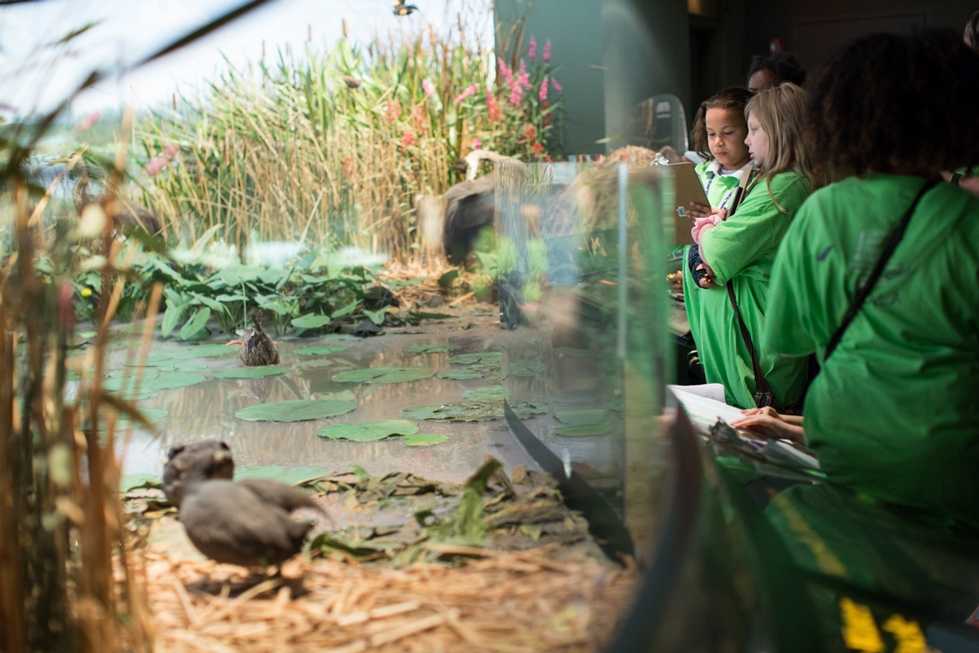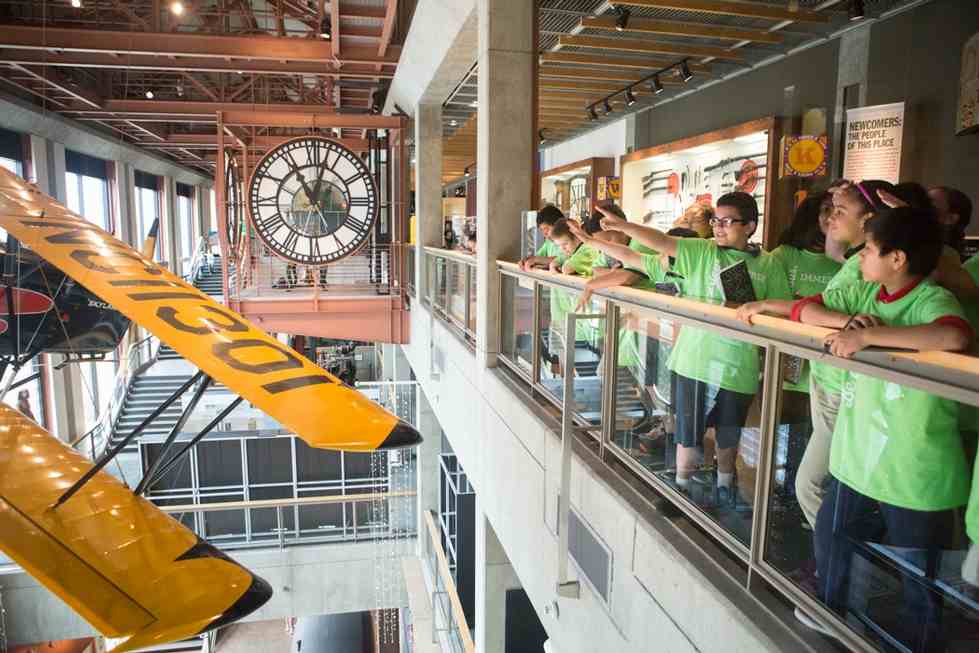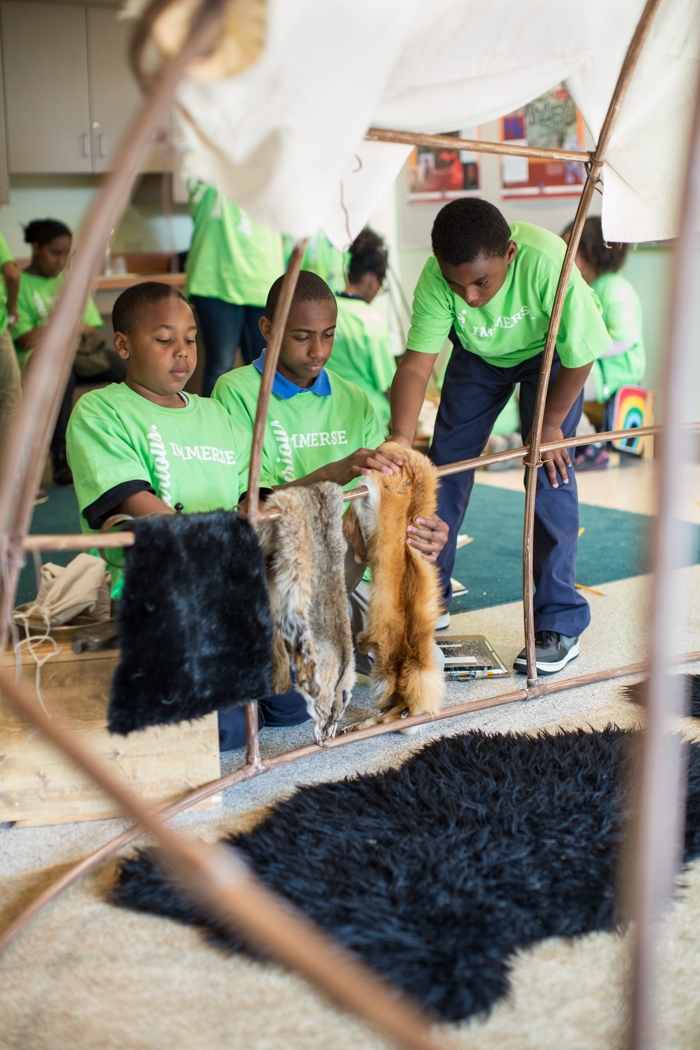Museum School
Learning filled with life
by Dottie Barnes
photos by Amanda Pitts
video by Jeremy Knickerbocker
Imagine a typical school classroom — desks, whiteboard, brick walls, a TV on an AV cart.
Now imagine a classroom big enough to suspend a 76-foot skeleton of a fin whale from the ceiling, a 3/4 scale re-creation of Grand Rapids in the 1890s and a planetarium with Digistar projection technology with immersive surround sound.
The latter describes just a portion of what is inside the Grand Rapids Public Museum in downtown Grand Rapids. The museum, filled with exhibits, artifacts, collections and more, now also serves as the Grand Rapids Museum School, where 60 sixth-graders are about to begin classes.

Students from Sibley Elementary take part in the museum's IMMERSE program, a week-long learning experience where students use the museum as their classroom. School will start there in the fall, thanks to a partnership that included Grand Valley faculty.
The Museum School, developed through Grand Rapids Public Schools, is a partnership with GRPS, the Grand Rapids Public Museum, city of Grand Rapids, Grand Valley, Kendall College of Art and Design (KCAD) of Ferris State University and Downtown Grand Rapids, Inc. It will open to students September 8.
Actor Ben Stiller saw people, animals and exhibits come to life in the movie, “Night at the Museum.” Students attending the Museum School will experience the same thing — in theory.
“The museum, city of Grand Rapids and our community will be the classroom for these students,” said Chris Hanks, principal of the Museum School. “These things are a gateway to all sorts of experiences, making for an empowering, exciting educational experience.”
Museum as a Classroom
GRPS and its community partners have been working on the development of the Museum School for about three years. Faculty from Grand Valley’s College of Education became involved more than a year ago, tapped for their expertise on Place Based Education and to help advise and direct the development of the school’s curriculum.
Hanks, who served as an assistant professor for six years in the College of Education before being selected as principal, said Place Based Education offers a different way of looking at the curriculum mandated by the state.
“The museum and surrounding community will serve as a living textbook,” said Hanks. “This approach to education means more activity, action and movement. It’s about blurring the lines between community and school. We want students to understand they are a part of a community, they can learn from their community and they can contribute to their community.”
The museum maintains a collection of more than 250,000 artifacts and specimens. Students who attend the Museum School will be able to touch, feel and see artifacts from throughout history every day.
“This hands-on approach to learning activates the mind,” said Mike Posthumus, assistant director of the Center for Educational Partnerships in the College of Education who helped develop the Museum School’s curriculum. “With the museum and surrounding community as the classroom, learning becomes more relevant and engaging because students are learning about the things they touch, feel and see every day.”
Posthumus said classes at the Museum School won’t resemble traditional math, science and language classes; the content will be covered in classes labeled “Patterns” and “Meanings.”
“We want students to understand their core subjects don’t exist in silos,” he said. “When you blend the concepts of patterns and meanings you have a really robust interdisciplinary learning experience for kids. We want to present these subjects in different contexts so students can think about how all subjects have patterns and all of the subjects influence culture. This is a key element of Design Thinking.”

Design Thinking
Grand Valley and KCAD faculty members worked to center the Museum School curriculum around Design Thinking.
Posthumus described the process as beginning to understand or empathize with the subject a person is dealing with.
“The museum and surrounding community will serve as a living textbook." — Chris Hanks, principal of the Museum School
“Design Thinking is really important in this curriculum. We need people who can look at a problem and break it apart into its patterns and its context and then find solutions where you might not expect it,” said Posthumus.
He said the curriculum is designed to take students through a challenge or problem and allow them to absorb as much as they can about the problem. Students then generate ideas and explore different solutions.
He said students will have the opportunity to implement at least one or more of their ideas with the hope that they will use what they’ve learned and do it better the next time.
“It all comes down to re-injecting curiosity and passion about what’s going on around them into education,” said Posthumus. “These students will be encouraged to fail. We want to see them make mistakes, learn from their mistakes and be comfortable asking questions and not be afraid of wrong answers.”
Hanks said the process of Design Thinking will help students think like problem solvers and have the ability to collaborate and work with others, which will connect them with 21st century skills.
“The museum is the glue that puts it all together,” said Hanks. “It’s more than just the novelty of artifacts and exhibits. These things give us context and inspiration. We discover artifacts, interpret them and understand them.”
National Model
Grand Rapids Public Schools received 160 applications for the 60 seats that were available.
The Museum School will eventually include grades six-12. Enrollment will grow by one grade level each year until 12th grade, but it will remain at 60 students per grade level.
Hanks said classrooms on the third floor of the museum were renovated to include the latest in classroom design and state-of-the-art technology to help teachers and students adapt to the school’s new approach to teaching and learning.
The Museum School project was mentioned by the American Association of Museum’s president as a symbol of the positive and changing role of museums in the U.S.
“The school can be a national model for others to duplicate and it could transform the way we think about teaching and learning,” said Posthumus.
“Our students will be the ones equipped to solve our most complicated problems, like climate change or hunger — you name it.”

Hanks said: “The students attending this fall will be the first graduating class of the Museum School seven years from now. They will define the culture of the school more than the teachers or myself.
“It’s humbling when I think about how we are trying to prepare students for a world that we know very little about. I think, more than anything, they will be well-equipped to respond to unforeseen challenges.”
